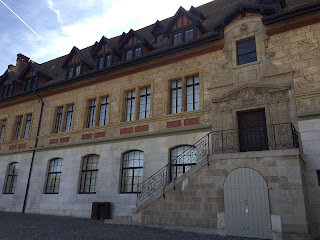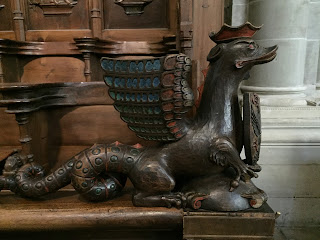On my own again, I flew to Geneva early in the morning to learn more about Calvin’s role in the Swiss Reformation.

Calvin was born in France in 1509 and went on to study law in Paris. In Paris he was influenced by Reformation ideas through the rector of the University, Nicolas Cop. When Cop openly argued for the Reformed agenda, he and Calvin had to leave Paris while a persecution of Protestants took place. Calvin went to Basel where he met Bullinger

and Farel

and published his Institutes of the Christian Religion (mentioned in Day One of the blog).
Calvin travelled to Geneva where he was coerced by Farel to help reform the church. Geneva voted to become reformed while Calvin was there in 1536.

Calvin started to create a set of parish rules, but so many people were upset he was kicked out of Geneva and lived in Strasbourg (mentioned in Day Two of blog). He was married there but three years later Geneva begged him to return. In 1541 he did and spent the rest of his life. The most prominent tribute to the Reformation is the Reformation Monument started in 1909 for Calvin’s 400th birthday.


The huge letters of “Post Tenebras Lux” are printed across the entire monument, the Genevan motto. Anyone know what it means? Yep, after darkness, light.


The four main figures are the main reformers who lived in Geneva, William Farel, John Calvin, Theodore Beza, and John Knox, with the Greek letters IHS for Jesus.

8 scenes are depicted across the monument including John Knox preaching in Giles, Scotland and instigating the Reformation there.

Luther and Zwingli have separate stones in front of the monument paying tribute to those who started the Reformation in Germany and German-speaking Zurich.


The monument faces the University and is directly under the City Hall who in 1535 voted to suspend Mass and introduce the Reformation under Calvin’s direction.

Saint-Pierre Cathedral is the most prominent and important church in Geneva.

Calvin was the pastor of this French-speaking church for the time he lived in Geneva.

He preached here twice every Sunday and once during the week, over 2,00 times in his lifetime. Luther couldn’t resist preaching where Calvin had stood.

This is Calvin’s chair where he sat during worship services.

Original seating of the chancel area has been preserved.

The details are amazing.
I like to think Calvin would also climb up the bell tower to look over the city of Geneva.

Education was a priority for Calvin since people needed to be able to read the Bible for themselves. As a result, Protestant Genevans had a much higher literacy rate than their Catholic neighbors. One of Calvin’s greatest accomplishments was founding the Academy in 1559.

When Geneva adopted the Reformation on May 21, 1536, they also decided to build a school which all children would be required to attend. With ten hours of lessons a day, six days a week, students did not have it easy!

The Academy became the forerunner of the University of Geneva and today the original building is a high school, appropriately called Calvin College.

My last Reformation stop was the International Museum of the Reformation where they were having a special edition on the printing press.

They had a rare replica of the Gutenberg Press and allowed people to print their own pages. The pictures tell the story.

I was happy to be able to make my page of the Bible home! Last thing was the lower streets where all the fancy stops were.

The center of the streets were for the horse drawn carts, replaced now with trolleys.

Everyone knows the Swiss make the best chocolate, so I went to a couple of the famous stores and bought a little (that’s all I could afford!).



They even had chocolates of Calvin!
I ended the day at the Water Jet at Sunset, one of the iconic features of Geneva.

What a beautiful sunset! I love this city!









No comments:
Post a Comment